For those allergic to snow, ice, and sub-freezing temperatures, there is an escape to national parks in the southern half of the United States, parks that offer sweeping panoramas, interesting wildlife along with warm and even hot temperatures, and lots to do and explore.
Most of these are places that summon lots of sunscreen, a good pair of shades, broad-brimmed hat, and a water bottle within reach. Maybe a pair of fins and mask, or backpacking gear. These destinations more than likely do not require you to worry about altitude sickness or frostbite.
For those desiring to add to their birding life lists, winter is the season to flock to South Florida to pan your spotting scope across Everglades, Dry Tortugas, or Biscayne national parks, and Big Cypress National Preserve. Looking for a new backpacking adventure? Big Bend, Guadalupe Mountains, and Saguaro national parks can be great destinations. Joshua Tree National Park is perfect for perfecting your climbing skills, and Padre Islands and Canaveral national seashores are great spots to plant your beach chair and read a good book while the waves wash ashore.
What follows is a short list of destinations for your consideration. Just remember, the coronavirus pandemic continues unabated, and there could be restrictions on where you can go or what programs are available. You might want to just bookmark the following parks for once the pandemic is history. The parks will wait.
Big Bend National Park, Texas
Great for: Backpacking, birding, hiking, night skies.

Sunset over the Chisos Range/Rebecca Latson file
Deep in West Texas on the border with Mexico, Big Bend isn't easy to reach, but the rewards make the effort worthwhile. The winter months are the best to visit if you don't like high heat. It is the prime backpacking season, and for those seeking to push themselves, the park's Outer Mountain Loop awaits.
"Big Bend is an International Dark Sky Park, with impressive night skies even if you’re staying in Chisos Basin. Out in the desert the sky was glorious on a clear night," reported Bob Pahre, who took his son on a challenging navigation of the loop last December.
"The Outer Loop offers an outstanding backpacking experience in a great, undervisited park – if you have desert backpacking experience and if you know that you can manage the challenges," he added in an article about the adventure. "If you don’t have that experience, try an overnight from the Homer Wilson Ranch or in the high country of the Chisos Mountains. Either, or both, will give you a good sample of the Outer Loop experience.
Big Cypress National Preserve, Florida
Great for: Hiking, birding, botany, canoeing/kayaking.
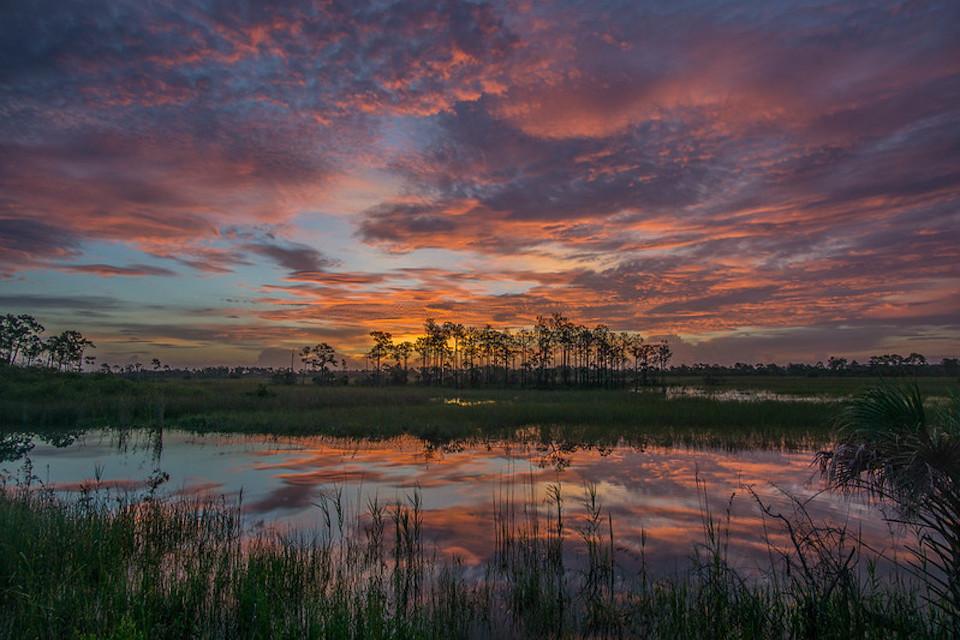
Sunset from the Turner River Road in Big Cypress National Preserve/NPS
Though perhaps not as well known as Everglades National Park next door, Big Cypress actually attracts more visitors. If you like nature and wildlife, you've probably already visited the preserve, or should have it on your to-do list.
"Big Cypress encompasses five distinct habitats across its 729,000 acres—hardwood hammocks, pinelands, prairies, cypress swamps, and estuaries. These habitats support a wide range of plant and animal species, including river otters, American alligators, bobcats, fox squirrels, and black bears," Kim O'Connell pointed out after visiting the preserve late last winter. "Importantly, the preserve offers the largest contiguous habitat for the endangered Florida panther in south Florida. Hundreds of bird species can be seen at Big Cypress throughout the year, including the white ibis with its curved orange beak; the blue heron (actually gray-blue) with a black stripe over its eye; and the silvery-black anhinga with its sharp, dagger-like beak."
Big Thicket National Preserve, Texas
Great for: Birding, paddling, backcountry camping.

Big Thicket offers more than 300 miles of paddling trails/NPS
Located about two hours from Houston, the preserve has no developed campgrounds and no entrance stations; only a few short roads -- most of them unpaved -- even extend into the park. As a result the best way to enjoy the Big Thicket is on foot or via the water, but it's easy to explore via short walks or float trips. There are creeks, bayous, and rivers that combined offer more than 300 miles to explore by canoe or kayak at Big Thicket, which boasts three official Texas Paddling Trails that range from 5 to 21 miles in length.
When you're out paddling, don't forget your binoculars to help with identifying birds in the preserve. The elusive, and likely extinct, Ivory-billed woodpecker once was a regular here, so keep your eyes and ears open.
Biscayne National Park, Florida
Great for: Snorkeling, scuba diving, fishing, birding.
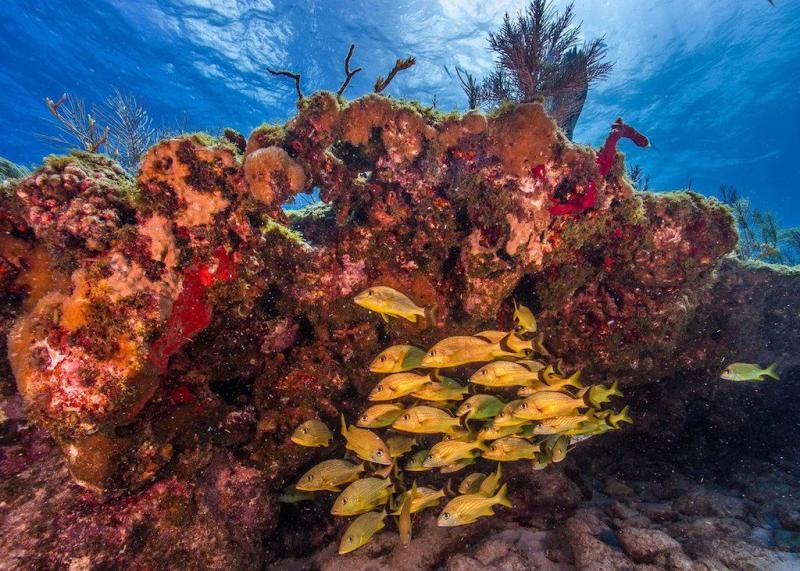
Biscayne National Park, aka water world/NPS
Biscayne is 95 percent under water. So if you're planning a visit, don't forget your snorkeling or scuba gear. Fishing also is a great pastime in the park, as are kayaking and canoeing.
"We were eager to explore, and donned our snorkel gear and made the plunge into the pleasantly warm 76° F water," wrote Jameson Clifton after visiting Biscayne for the Traveler in 2019. "We floated on the surface, above the colorful marine oasis. It provided a sense of tranquility. Streaks of sunlight illuminated the anemones, which swayed gently back and forth on the seafloor, mesmerizing in the rolling swell. It was a stark contrast to the rough voyage just moments before. The only sound was the soft rumble of the waves, and a steady rhythm with each breath: in and out.
"While most national parks are dominated by landscapes, Biscayne National Park is unique in that 95 percent is covered by water. There are 10,000 years of colorful human history here nestled among mangrove forests, coral reefs, sea grass meadows, lighthouses, and shipwrecks. The setting has been shaped by Native Americans, farmers, smugglers, fishermen, pirates, and presidents," he added.
For birders, Jones Lagoon is a great place to view a rookery from your boat, but be sure not to get closer than 100 yards so as not to disturb the birds. You can find six cursory paddling guides on the park's website.
Canaveral National Seashore, Florida
Great for: Kayaking, fishing, birding, history.
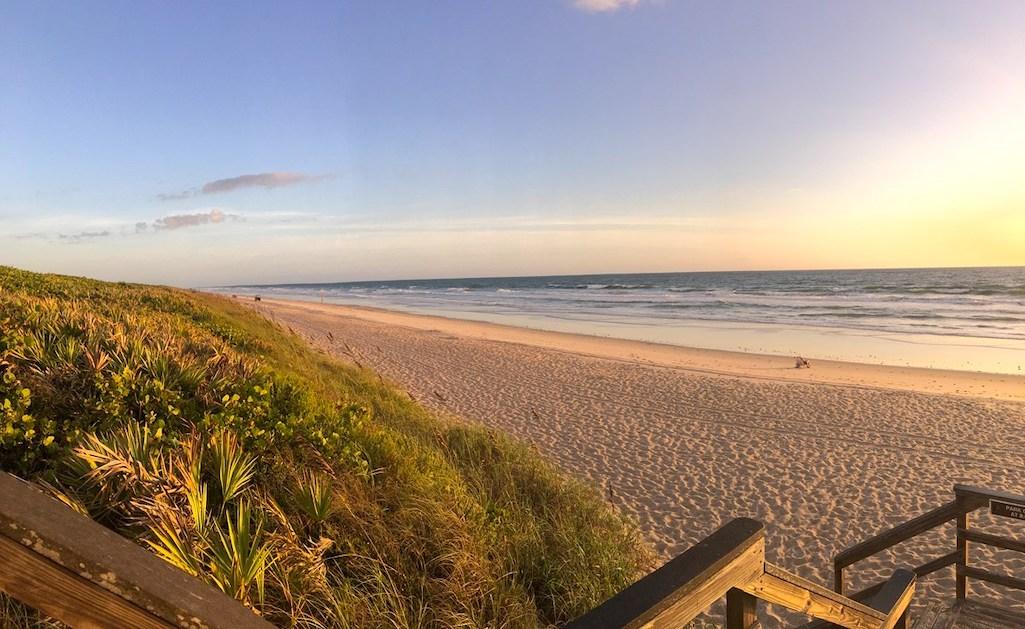
Seaside splendor at Canaveral National Seashore/NPS
It may be cold and snowy where you are, but it’s still beach weather at the Canaveral National Seashore. Winter at the seashore is less about diving into the waves, and more about other activities available in the park. Folks are doing things like fishing, hiking, kayaking and camping. The visitor count is lower this year because of COVID, but people are yearning to get outdoors.
The seashore's riches are more than just biological. Here, along the longest undisturbed stretch of barrier island on the Florida coast (24 miles), there are 150 documented archaeological sites within the seashore, including 40-foot Turtle Mound, one of the tallest Native American shell mounds on the east coast of Florida. Ranging some 600 feet long, this pile of shells --an estimated 1.5 million bushels-- was thought to have once stood 75 feet high before years of erosion and modern human activity. Dating back to 800 AD, the midden is constituted mainly of oyster shells, a key food source for the Timucuan Indians.
Channel Islands National Park, California
Great for: Kayaking, scuba diving, snorkeling, hiking.
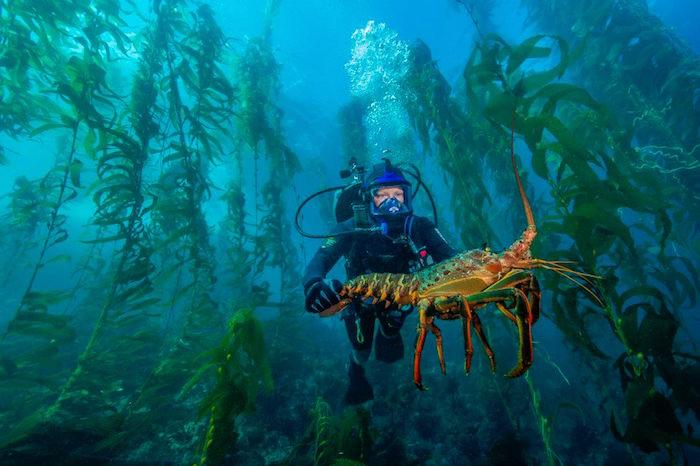
The kelp forests of Channel Islands National Park attract divers, snorkelers, and lobsters/NPS, Brett Seymour
Forests of kelp waving to and fro in the currents. Archaeological and paleontological surprises. An incredible assemblage of wildlife that has the area known as the 'Galapagos of the North.' These are just some of the reasons to explore Channel Islands National Park off California's coast.
The five islands that comprise the national park that started out in 1938 as a national monument long have lured the curious, industrious, and adventurous. Native peoples found the Channel Islands between 15,000-20,000 years ago, Spanish explorers landed here in the mid-1500s, and abalone harvesters and sheep and cattle ranchers arrived roughly 300 years later.
Those who make the effort to visit Channel Islands National Park find themselves surrounded by an ocean where the golden fish, the Garibaldi, is prolific along with hundreds of other species in an underwater forest of kelp beneath wave-battered sea caves. Imagine a place that is still California as it once was, a century ago, with adobe ranch houses, sweeping vistas of cliffs and beach, mountains and valleys, grasslands and cypress groves, and unbelievable quiet.
Daytime hightime temperatures ranging from the 60s into the mid-70s might make it too cool for some to get wet, but the winter months nevertheless are a great time to visit, what with gray whales coming through from the end of December into April, Northern elephant seals coming ashore to pup, and harbor seals pupping late in winter.
Congaree National Park, South Carolina
Great for: Kayaking/canoeing, birding.
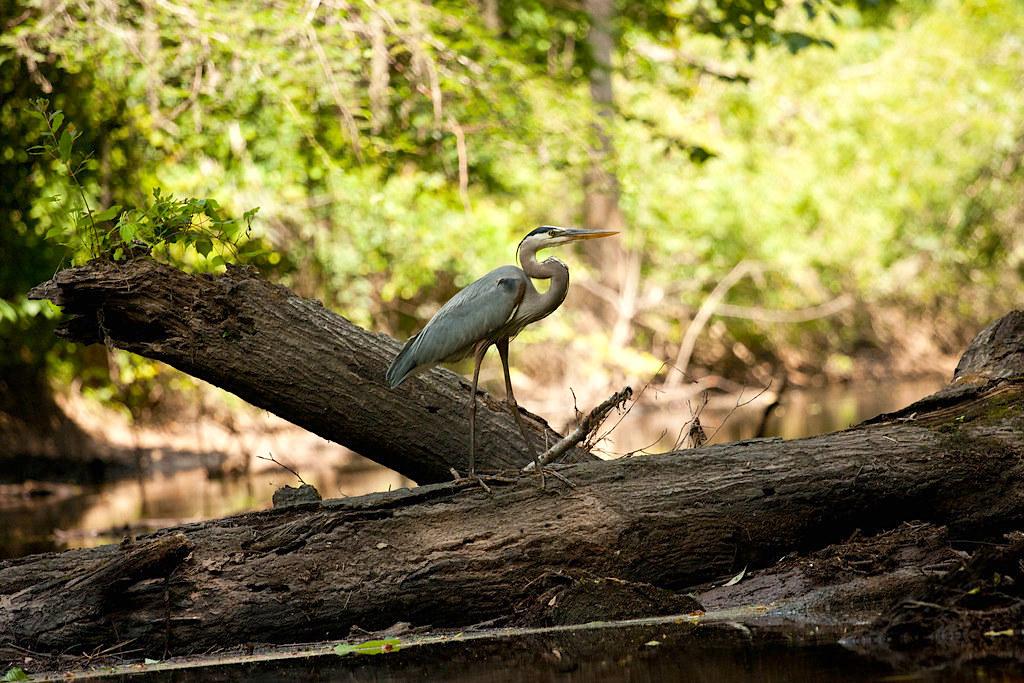
Serious birders flock to Congaree National Park/NPS
There are crown jewels in the National Park System, and then there are the overlooked parks. Congaree is one of the latter.
"What can you say about a place that’s an International Biosphere Reserve, a Globally Important Bird Area, a National Natural Landmark, a federally designated Wilderness Area, and an Outstanding National Resource Waters designee?" asked Bob Janiskee, Traveler's emeritus quizmeister and driver of 'parkhood' for Congaree. "Located smack-dab in the middle of South Carolina, just a half-hour’s drive from the capital city of Columbia, Congaree National Park preserves North America’s largest remaining old-growth bottomland forest.
"Although this nearly 27,000-acre park has around 600 acres of piney uplands, including about 200 acres of valuable longleaf pine habitat, its ecological centerpiece is a virtually pristine 12,000-acre tract of floodplain forest," he added a decade ago while describing Congaree with as much enthusiasm as a proud father does when gushing about his children. "The bottomlands of the Congaree Swamp, which look pretty much the way they did when Native Americans hunted there, are mantled with bald cypress, tupelo, laurel oak, sweet gum, water hickory, loblolly pine, and other trees inclined to grow to unusually large size."
Daytime temperatures November through February usually climb into the mid-50s, and you can run into blue sky "chamber of commerce" days that are perfect for paddling and camping. But ... overnight temperatures can dip below freezing, and flooding isn't unusual during these months. As always, check local conditions before heading out and always be prepared for the unexpected.
Cumberland Island National Seashore, Georgia
Great for: Birding, beach combing, history.
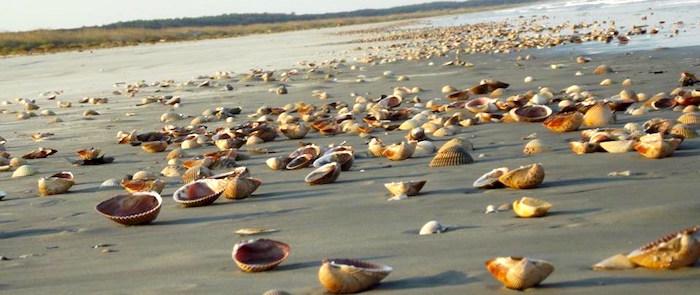
Winter months can be a great time for beach combing in places such as Cumberland Island National Seashore / NPS, Audrey Bohl
"One Georgia destination we seldom hear about is Cumberland Island National Seashore which, in our opinion, is the state’s single most rewarding destination," say David and Kay Scott, Traveler's lodging experts. "Of the many units managed by the National Park Service that we've visited over the years, we have found few that offer a better experience than Cumberland Island. If you don’t want to take our word for it, ask someone else who has been there."
Cumberland Island National Seashore embraces a bucolic coastal setting on Georgia's longest barrier island. It's a place rich in human history, features settings attractive to both birdlife and loggerhead sea turtles, embraces dense maritime forests and ecologically vital salt marshes, and claims nearly 10,000 acres of officially designated wilderness.
"One of America’s most beautiful Atlantic beaches, often with no one else in sight, rewards strollers with an abundance of sand dollars and shells," the Scotts noted following one of their visits. "Visits to the northern portion of the island offer visitors the opportunity of stepping inside the intimate First African American Church where on a September day in 1996 John Kennedy, Jr. married Carolyn Bessette.
Cumberland Island is a world away from what most of us have experienced in our nation’s more popular national parks.
Death Valley National Park, California/Nevada
Great for: Hiking, geology, night skies, history.

You can't get much lower in North America than Badwater/Kurt Repanshek file
Death Valley is misunderstood by many visitors. Many come just to say they've visited the hottest place on Earth, or the lowest point in North America, but there's so much more here than ticking off those experiences and moving out.
The park is an open book, geologically, featuring sweeping alluvial fans, far-flung sand dune complexes, even volcanic craters.
There's also an abundance of intriguing and interesting history, from the old Harmony Borax works that spawned the 20-mule team that hauled borax out of today's national park, and Scotty's Castle (which is closed at least until 2022), a wonder when it was built in the 1920s and even today. Not only did Albert Johnson see that there was a solar heating system at work, but he also had a Pelton water wheel turbine installed to generate electricity for the place. Too, an evaporative cooling system employed indoor waterfalls and even wet burlap to keep things inside the castle relatively cool on those 100-degree summer days.
You can stand 282 feet below sea level at Badwater, or climb to the top of Telescope Peak, which rises 11,049 feet above sea level (and 11,331 feet above Badwater). Of course, winter might not be the best of time to climb Telescope Peak, which does get snow. But far down below the winter months are wonderfully mild (compared to summer's 115°+ Fahrenheit heat) and the park's nine campgrounds are open (Check the park's website before you head to Death Valley for camping, as the coronavirus pandemic has led to the temporary closure of the campgrounds.)
Show up in late winter after atypically wet months of December and January and you could encounter a "super bloom" of wildflowers that takes your breath away.
Dry Tortugas National Park, Florida
Great for: Kayaking, snorkeling, scuba diving, birding, Civil War history.
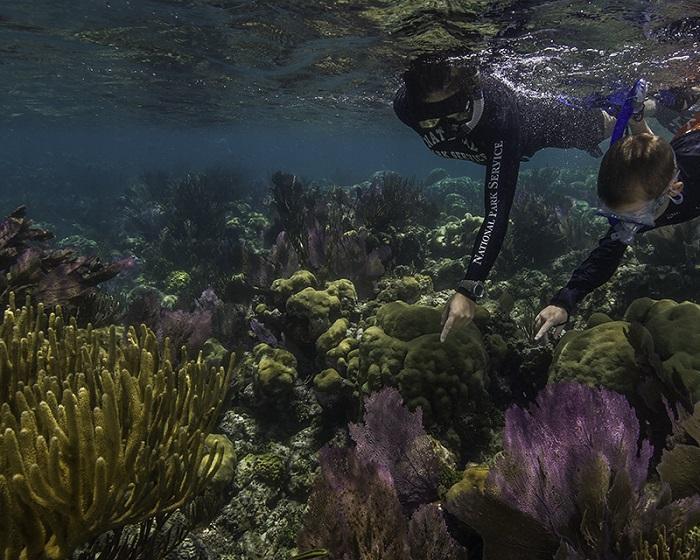
Dry Tortugas' waters are rife with coral reefs and gardens that attract snorkelers and scuba divers/NPS, Brett Seymour
This is not an easy park to reach, (but it's easier than getting to Big Bend, and the rewards are just as great.).
Seventy miles off the southern tip of Florida, the park today harbors not only Civil War history in massive, and incomplete, Fort Jefferson, but its marine resources are spectacular, and its sunken wrecks tell tales from the days when wind, not fuel oil, powered ships. The natural beauty is reason enough to visit.
“I lay there and thought that the island at night would be the memory that would stick with me most,” wrote Mark Woods of Dry Tortugas in Lassoing the Sun: A Year In America's National Parks, which described his year-long odyssey of national park adventures. “Then I woke up to the first rays of sunlight on my final morning here.”
What Woods saw was water, “so mirror smooth that it was hard to tell where light blue fluid ended and light blue air began. The boats in the harbor appeared to be floating in midair.”
Everglades National Park, Florida
Great for: Birding, fishing, botany, backcountry kayaking.

Sunrises at Flamingo can be unforgettable, no matter the season/NPS file
There are the perceptions of Everglades National Park -- always wet, humid, buggy -- and then there are realities.
"Before I came to the Florida Everglades, I imagined only a province of swamps and sawgrass—a watery place, nearly submerged. So I am surprised to be crunching along a trail deep in a dry landscape that, to my untrained eye, resembles something like the Serengeti Plain," Traveler Contributor Kim O'Connell wrote after a late winter visit. "As far as I can see, an open field of shrubs and grasses is studded with towering slash pines that stand apart from each other, perforating the blue sky. Each tree makes its own impression in this open forest, no two of them the same, like fingerprints. I bend down to touch the trail itself and am surprised to find that it’s mostly rock—pockmarked limestone, to be exact. "
This is an amazing place, and in winter it's less buggy than summer and the chortling, chirping, screeching, and cawing of multitudes of multi-colored birds that arrive to breed reverberates across the sawgrass prairies.
And the fishing isn't bad, either.
Haleakalā National Park, Hawaii
Great for: Night skies, hiking, photography, flora and fauna.

The roof of Haleakalā isn't easy to reach, but rewards with some incredible vistas/NPS
The winter months are a great time to explore Haleakalā National Park, particularly if you're looking to flee the snow, ice, and cold temperatures on the mainland. But come prepared for a very diverse experience and plan to spend a great time hiking around getting to know the park.
Haleakalā -- which translates to "House of the Sun" -- is found on the island of Maui and is divided into three different sections: the Summit Area (mountain), Kīpahulu Area (coastal), and the Wilderness Area (mountain). Each region displays its own beauty and unique qualities; however they all offer a multitude of activities for visitors of all ages.
One of the most popular activities to partake in at this park is sky-watching. Whether it be day or night, the clouds and stars form picture-perfect skies that will leave everyone speechless. This also leads to a bounty of photography options, everywhere throughout the park.
Throughout Haleakalā, you will have the opportunity to view a multitude of wildlife species. Along the shores of the Kīpahulu area, keep an eye out for whales, turtles, dolphins and sea birds. Ever heard of nēnē or endemic honeycreepers? They are unique species that can be found in the lower, wetter parts of the wilderness area.
Hawai'i Volcanoes National Park, Hawaii
Great for: Geology, botany, birding, hiking.
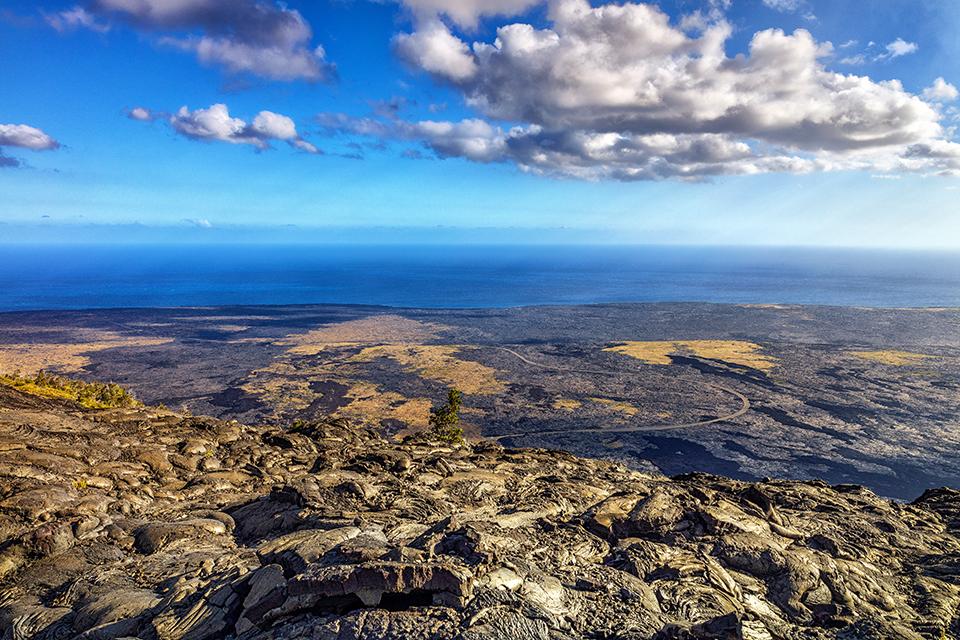
A winter view beyond the lava flows, Hawai'i Volcanoes National Park / Rebecca Latson, file
Hawai’i Volcanoes National Park is a treasure of vents and caves, craters, and lava tubes. But it's really more than that.
"Hawai’i Volcanoes National Park has, you could say, a personality disorder. There are few national parks that offer so many varied experiences — seacoast, rain forest, volcanism, even snowfields — as does Hawai’i Volcanoes," Traveler Contributor Rebecca Latson said after visiting the park.
With such a big park -- more than 335,000 acres -- and with such diverse landscapes, it might be hard to settle on your favorite place. But Latson did.
"My very favorite spot in this park was the Kilauea Iki Trail. It’s not so much a single spot, as it is a 4-mile traverse through a lush rainforest with every shade of green, then out over jagged chunks of cooled ‘a’a lava before reaching the broad floor of a solidified lava lake," she said. "It was a pretty cool feeling to think I was literally walking on what once was a roiling, searing lake of molten rock!"
Joshua Tree National Park, California
Great for: Bouldering, birding, desert botany, hiking, history of hard-scrabble ranchers and miners.
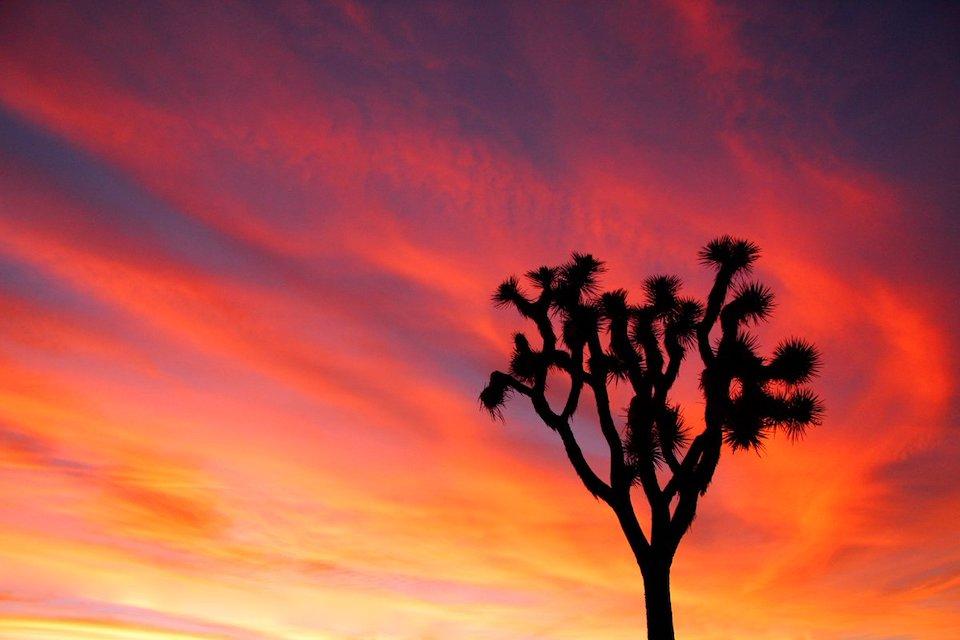
Joshua Tree at sunset/NPS, Brad Sutton
If you're fascinated by desert botany, an avid birder, enjoy bouldering, or want to learn a bit about those who tried to tame the rugged desert landscape of Southern California, Joshua Tree meets the bill. It can be magical and astonishing, intriguing and interesting, but the landscape also doesn't suffer those who come unprepared.
"Desert sunsets always seem to be amazing and this evening’s was no exception. Throughout the camp, people were clambering to high places with cameras ready. Childish voices sang out their fun while adults stood quietly staring westward," Lee Dalton recounted for the Traveler after a visit to Joshua Tree in 2012. "Joshua trees of many sizes and grotesque shapes silhouetted themselves against colorful sky. Cameras clicked everywhere. And as the sun dropped into the horizon, temperature dropped, too; more than 15 degrees since I’d left my portable motel to watch the sunset.
"... There are 800,000 acres to explore in Joshua Tree and much of it is wilderness," added Dalton. "It’s the place where the Sonoran Desert meets the Mojave Desert. A place where slight differences in elevation make huge differences in moisture and plant life. It’s not a place that can be explored thoroughly from the paved roads only. A number of unpaved roads lace the place and lead to sweeping vistas and breathtaking discoveries. But some require four-wheel drive if you want to be sure of making it back to civilization again."
Joshua Tree is a beautiful, but unforgiving, park. You must be self-sufficient, armed with good navigation skills, and be able to check off the seven skills all hikers should be proficient in. If you can't, stick to the front country. There's still lots to admire.
National Park of American Samoa, American Samoa
Great for: Snorkeling, scuba diving, hiking in the rain forest or along the beaches.

A picture is enough to get National Park of American Samoa on your travel schedule/NPS
Imagine walking out of a lush, tropical forest to stand on a rocky beach with pounding waves, and in every direction you see ocean or tree-covered hills, but no signs of human presence.
"It is impossible to visit NPSA without immersion in the people, culture, and daily life of American Samoa itself," Traveler reader Rick Bannerman noted after he visited this slice of paradise, the only unit of the National Park System south of the equator. "Visitors will find that their non-Samoan cell phones probably will not work there. The speed limit for cars on the entire island is 25 mph. Everything which you encounter will be slower than you are used to on the mainland, and I found this to be exactly what I needed."
"It was tremendously refreshing to find out how to wear a lava lava, the ubiquitous wrap-around garment worn by both men and women," he added in an article for the Traveler. "I found that the more I wore this comfortable garment, the more smiles I got from the Samoans I met. Strangers would walk past me and comment, 'Nice lava lava,' as thanks for embracing their culture."
Sagauro National Park, Arizona
Great for: Hiking, birding, Sonoran Desert botany.

Saguaro National Park's Cactus Forest is a mesmerizing place/Lianda Ludwig
Despite its arid appearance, Saguaro boasts a rich and diverse landscape. It's namesake cacti aren't the only desert dwellers in the park. There also are prickly pear, octillo, mesquite and cholla. Wildlife range from Antelope jackrabbits, bobcats and coatimundi to Gila monsters, black bears, and javelina, a pig-like critter that travels in groups.
Winter months in the park are decidedly more comfortable, temperature-wise, than July and August. The milder temperatures encourage exploration of the park on foot, with or without a backpack. Though the park is less than 100,000 acres in size, split in two districts (Rincon Mountain District and Tuscon Mountin District), you can find solitude by heading out early in the morning or late in the afternoon to catch the evening sunset while most others head back to Tuscon for dinner.
Wildlife watching is good in the Cactus Forest, where you might spot a Pyrrhuloxia Cardinal or even a gila monster.
Virgin Islands National Park, U.S. Virgin Islands
Great for: Snorkeling, hiking, sailing, history.
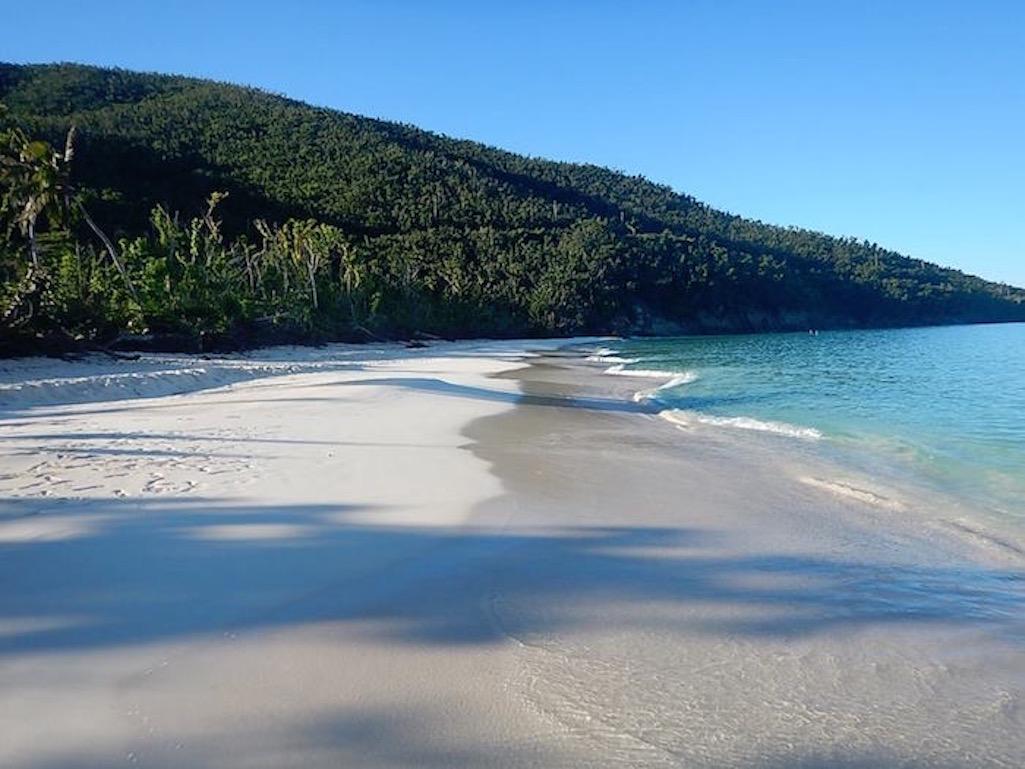
Sugar-sand beaches and turquoise waters await at Virgin Islands National Park/NPS
What's not to like about leaving the cold and snow behind for sugar-sand beaches lined by palm trees, great snorkeling, scuba diving, and sailing, or exploring trails and their vestiges of ancient civilizations? And if you're a student of history, even if it's dark, the island of St. John that holds the national park also features remnants of European domination of paradise.
The Tradewinds (the Easterlies) dominate the weather in the Virgin Islands, blowing east to west across the tropical Atlantic. The winter tends to bring stronger winds and less rain, and the summer tends to bring more rain and lighter winds.
In winter, cold fronts moving off the continent sometimes bring the Christmas winds down from the north. The fronts do not bring cold air as far south as the Virgin Islands, but they can create large waves breaking on the north shore beaches -- which is great for surfing, but can also pose some danger if you're not paying attention.
There are enough beaches to offer a different snorkeling adventure every day of the week.
There you have it. A rich collection of parks to explore any time of year, really, but with an emphasis on the winter months. You won't be disappointed.



Comments
Great review! Kayaking at the Channel Islands National Park on a guided tour with a naturalist is out of this world!
It's as if the pandemic doesn't exist. Southern California parks are currently under a state travel lockdown - campgrounds are closed, hotels are closed, restaurants are to-go only, etc. It's irresponsible to be sending people to these parks right now. You folks should know better.
Steve, we understand the current situation in California, and that's why we inserted high up this note:
The site needs clicks. And plenty of dumb and selfish people are still traveling, so their clicks are as good as anyone else's.
Comte - stay home and you will be just fine - unless of course you are destined to get the disease. Meanwhile others will travel to what is likely the safest locations available while enjoying their NPT clicks.